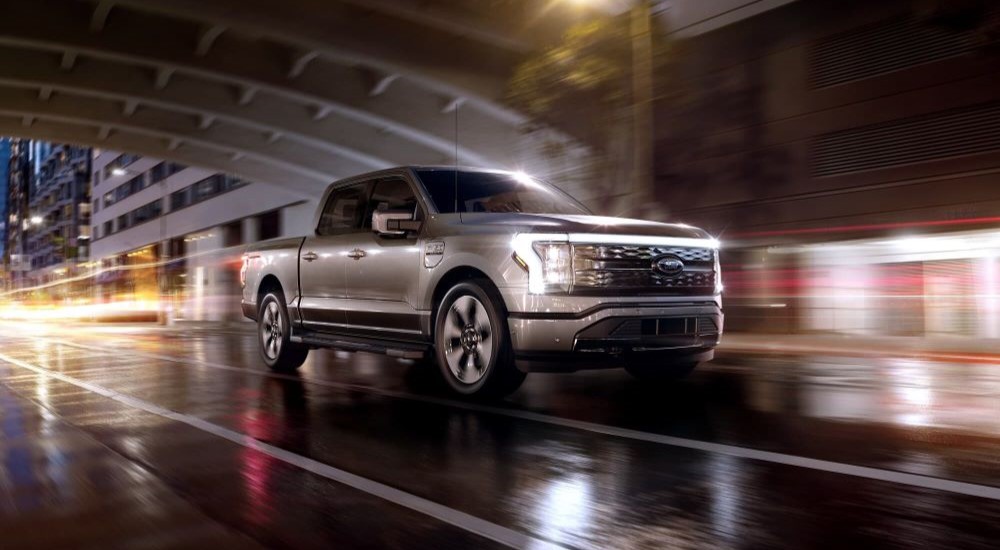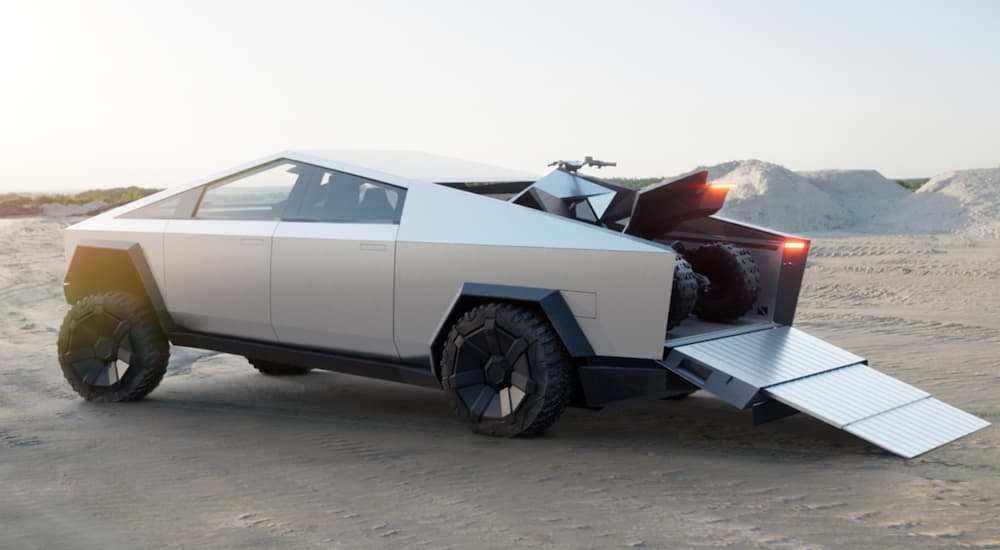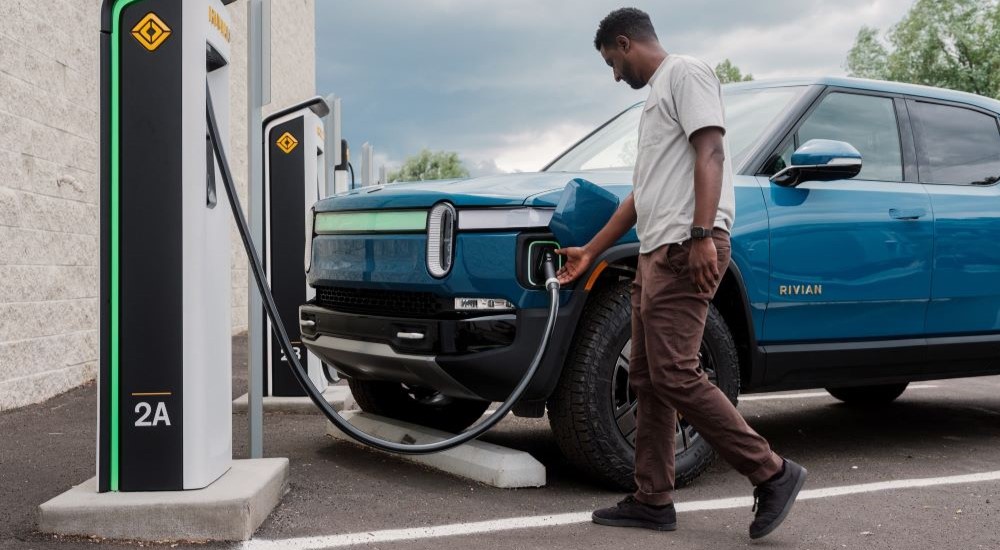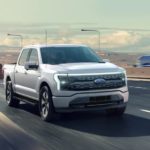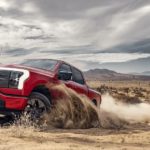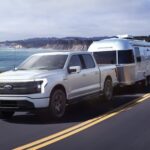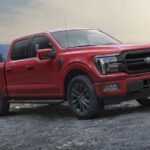Full-size pickup trucks have traditionally been painted as gas-guzzlers, but with electrification coming for a wider and wider variety of vehicles, that’s no longer necessarily true. All-electric automakers Tesla and Rivian are trying to shake up the market with the Cybertruck and R1T, respectively, but they aren’t the only game in town. If you want to stick with a brand that’s a known entity, it’s easy to find the Ford F-150 Lightning for sale at a dealership near you and get something that looks and feels a lot like America’s best-selling truck for over forty years and counting, but that runs on an all-electric powertrain.
Which of these approaches results in a better truck, though? Is it better to start from scratch and design a unique EV truck or build on the back of a tried and true formula? Let’s take a look at the Cybertruck, R1T, and F-150 Lightning and see how they stack up against each other. We’ll weigh their pros and cons across a range of categories and see which one comes out on top.
Starting With the Looks
Let’s start by just taking a look at all three trucks. The Cybertruck is certainly the most eye-catching, but that’s not necessarily a good thing. Its design has been nothing if not controversial since it was first unveiled back in 2019, with fans of Tesla praising its sci-fi aesthetic and detractors deeming it an angular eyesore. Certainly, if you want a truck that looks like, well, a truck, then you might not appreciate the look Tesla is going for. Further, some elements seem to value adding to the bold appearance more than making things easy on the user: the design of the cargo bed makes it difficult to access from the side compared to a traditional design, and the angles up front don’t seem ideal for visibility.
The Rivian is much more recognizable as a pickup truck, but that doesn’t mean there’s no room for modern design choices and unique touches. The front face screams “EV” with its design language, as do the flush door handles. Overall, the R1T is fairly handsome and strikes a good balance between what you expect a truck to look like and what you expect an EV to look like.
On the most traditional end of the spectrum, we have the F-150 Lightning. Ford knows that the F-150 is a beloved bestseller, so it isn’t aiming to fix what ain’t broken. The Lightning has a few different touches from the non-EV F-150, like its end-to-end lighting up front, but it doesn’t especially stand out in the lineup of F-Series trucks. That might disappoint drivers who want their futuristic vehicles to look the part, but there are plenty of drivers who enjoy the classic look of a pickup and only care about the tech underneath being cutting-edge.
Interior Design
The three trucks fall along similar lines when it comes to their interiors. The F-150 Lightning has a similar interior to its gas-powered counterpart, though it sports a much larger 15.5-inch infotainment touchscreen that pairs with a digital driver information center set back behind the wheel. The layout is intuitive and provides plenty of space for passengers. Physical buttons and dials are still around, both on the dashboard and the steering wheel, for a tactile experience.
Things inside the R1T are a bit more modern, with the touchscreen responsible for controlling most features in the truck, a flat digital driver information center behind the wheel, and the strange omission of a glove compartment. Apple CarPlay and Android Auto are also not present, which is a big drawback for drivers who appreciate the convenience of easy smartphone connectivity. Overall, though, it still has a reasonably familiar look and feel.
One word comes to mind when looking at the Cybertruck’s interior: stark. The touchscreen in the center of the dash is the only display for the driver, so you have to shift your eyes down and to the right to see everything, even your speed. The Cybertruck does have a glove compartment…of sorts. It’s more of a drawer than a traditional compartment; it’s not particularly spacious and doesn’t have a built-in handle, so you need to use the truck’s touchscreen to open it. Again, the truck’s design really feels like being different just for the sake of it and doesn’t seem to be putting practicality at the top of the list of priorities.
Pricing
For 2024, the Rivian R1T starts at $69,900, and the Tesla Cybertruck begins at $79,990. Tesla should be adding a lower-priced version to the lineup, but it won’t be available until the 2025 model year, and it will only provide rear-wheel drive. While the F-150 Lightning can certainly get pricey if you opt for a higher trim level (the top-trim Platinum Black will run you $97,995), there are more affordable models available, all of which come standard with all-wheel drive. The Pro starts out at $54,995, giving drivers an entry-level option to help them come in under budget.
Towing & Payload
When it comes to towing, all three trucks are pretty close to each other. Both the Cybertruck and the R1T boast a maximum towing capacity of 11,000 lbs. The F-150 Lightning is a little behind that, but not by much at a still-respectable 10,000 lbs. When it comes to payload, Tesla claims to be able to haul up to 2,500 lbs, while the Ford can accommodate up to 2,200 lbs. Rivian falls a bit behind at a mere 1,760 lbs of payload capacity.
Battery Range
The R1T can go an estimated 410 miles on a charge with its dual-motor setup paired with the largest available battery, but it has a range of just 270 miles in its base configuration. The F-150 Lightning delivers an estimated 320 miles with its extended-range battery. Tesla claims that the Cybertruck can deliver 340 miles of range in its dual-motor configuration and 470 miles of range with an optional range extender, but this would be mounted in the cargo bed and thus come at the expense of storage space.
Safety Ratings
The National Highway Traffic Safety Administration (NHTSA) has given the Ford F-150 Lightning a five-star overall safety rating for every model year that’s been released so far, from 2022 to 2024. We would love to compare this to the ratings for the Cybertruck and R1T, but the NHTSA has not rated either model at the time of writing. While they both have a solid lineup of driver assistance features, drivers who like the peace of mind of a five-star safety rating from a trusted government agency might be a bit wary of the untested models from automakers that haven’t been around for too long, especially compared to Ford—a company that’s over a century old.
Unique Features
Each of these trucks has a feature that stands out to us as a unique benefit. The Cybertruck has rear-wheel steering and a unique variable-ratio steer-by-wire system that gives it unexpected agility for a vehicle of its size. The R1T has a third major cargo option beyond the front trunk and cargo bed: a gear tunnel between the cab and bed that stretches from one side of the truck to the other and can be sealed to keep out weather and prying eyes. The F-150 Lightning’s big benefit is probably the best publicized one: it can power an entire house in case of a blackout. You need to have your hose wired properly for this to work, and the feature requires the extended-range battery, but with everything in place, you can use the truck’s battery to keep your house running for several days if the power grid lets you down.
Who Wins?
All three trucks bring good and bad elements to the table, and different models are best at different aspects of being a truck, which makes this head-to-head a bit complicated to judge. But considering everything, we think the F-150 Lightning stands out as the best pick. It’s well-rounded and reliable, with a solid design and a lot of great features. There’s a reason that the Lightning has been named Kelley Blue Book’s Best Buy for the Electric Truck category for both years the category has existed and was named North American Truck of the Year for 2023. Ford brings truck-building experience to the table that the newer startups just can’t match, and it shows in the F-150 Lightning.
